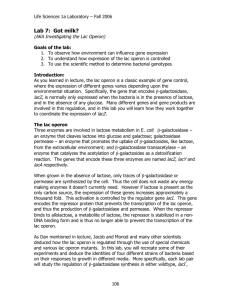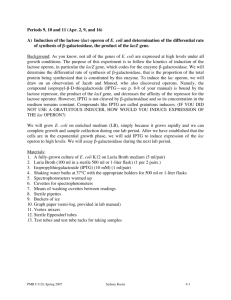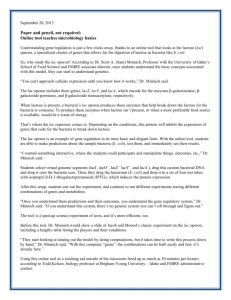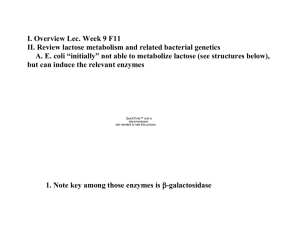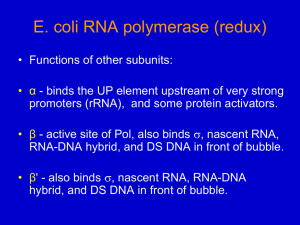Gene Regulation in vivo: The Lac Operon
advertisement
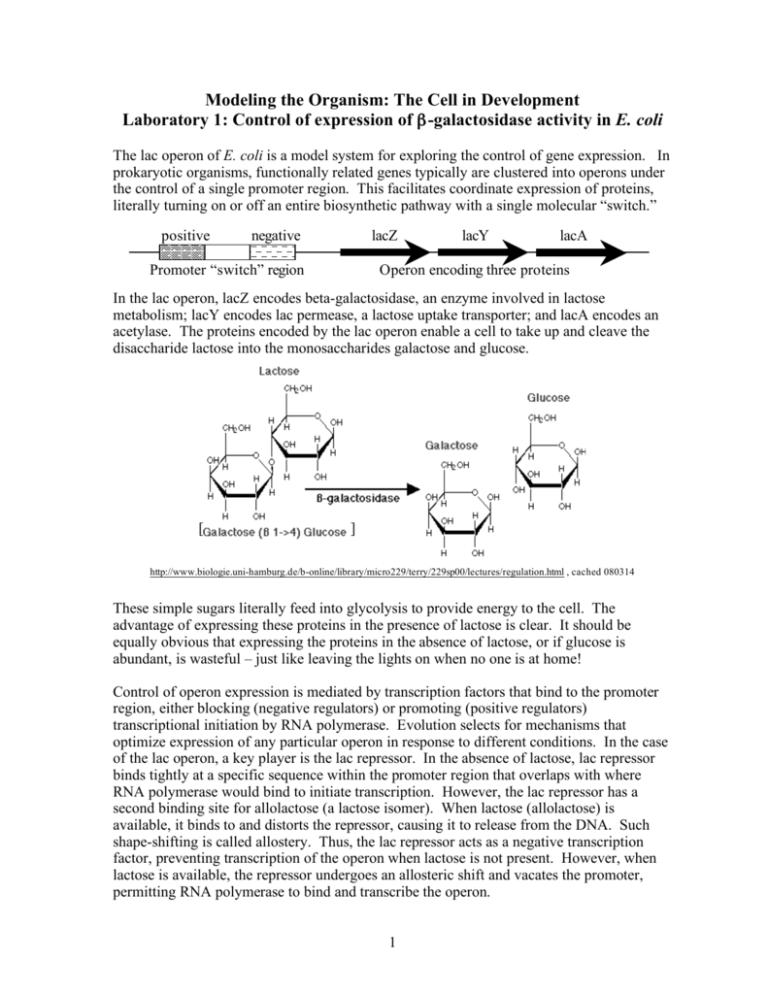
Modeling the Organism: The Cell in Development Laboratory 1: Control of expression of β-galactosidase activity in E. coli The lac operon of E. coli is a model system for exploring the control of gene expression. In prokaryotic organisms, functionally related genes typically are clustered into operons under the control of a single promoter region. This facilitates coordinate expression of proteins, literally turning on or off an entire biosynthetic pathway with a single molecular “switch.” positive negative lacZ Promoter “switch” region lacY lacA Operon encoding three proteins In the lac operon, lacZ encodes beta-galactosidase, an enzyme involved in lactose metabolism; lacY encodes lac permease, a lactose uptake transporter; and lacA encodes an acetylase. The proteins encoded by the lac operon enable a cell to take up and cleave the disaccharide lactose into the monosaccharides galactose and glucose. [ ] http://www.biologie.uni-hamburg.de/b-online/library/micro229/terry/229sp00/lectures/regulation.html , cached 080314 These simple sugars literally feed into glycolysis to provide energy to the cell. The advantage of expressing these proteins in the presence of lactose is clear. It should be equally obvious that expressing the proteins in the absence of lactose, or if glucose is abundant, is wasteful – just like leaving the lights on when no one is at home! Control of operon expression is mediated by transcription factors that bind to the promoter region, either blocking (negative regulators) or promoting (positive regulators) transcriptional initiation by RNA polymerase. Evolution selects for mechanisms that optimize expression of any particular operon in response to different conditions. In the case of the lac operon, a key player is the lac repressor. In the absence of lactose, lac repressor binds tightly at a specific sequence within the promoter region that overlaps with where RNA polymerase would bind to initiate transcription. However, the lac repressor has a second binding site for allolactose (a lactose isomer). When lactose (allolactose) is available, it binds to and distorts the repressor, causing it to release from the DNA. Such shape-shifting is called allostery. Thus, the lac repressor acts as a negative transcription factor, preventing transcription of the operon when lactose is not present. However, when lactose is available, the repressor undergoes an allosteric shift and vacates the promoter, permitting RNA polymerase to bind and transcribe the operon. 1 lac repressor active active RNA Pol lac repressor inactive allolactose RNA Pol What if lactose is available, but glucose is also plentiful? When ATP levels in a cell are high, levels of the second messenger cyclic AMP (cAMP) are low. When ATP levels drop and the cell “starves,” cAMP levels rise. cAMP binds to another transcription factor called catabolite activator protein (CAP), causing it to undergo a different allosteric shape-shift and binds to a sequence just upstream of the RNA polymerase binding site. CAP binding sites are found in many operons involved in the utilization of different sugars. When bound to DNA, the [CAP + cAMP] complex enhances RNA polymerase binding, turning up the volume. Thus CAP is a positive transcription factor that increases expression of activated operons. CAP CAP +cAMP RNA Pol Note that if the cell were starved but lactose was not present, CAP would bind but lac repressor would block RNA Polymerase binding, and wasteful expression would be kept to a minimum. However, if lactose became available, then expression would be maximally induced and the cell would switch to utilizing the new carbon source. 2 In a sense, gene expression acts as a computer. The program is written in genomic code; transcription factors act as positive and negative inputs that are integrated to generate output in the form of transcription and translation of specific protein products. Gene expression is coordinated at both global (starvation) and specific (lactose) levels, optimizing the cellular response to different environmental conditions. Elegant! Pre-lab question: Given a “hungry” culture of E. coli and a choice of carbon sources (glycerol, glucose, lactose), design an experiment to test one aspect of the regulatory program described above. Be sure to state your hypothesis clearly in your lab notebook. Include predictions of what you expect to see with respect to lacZ (beta-galactosidase) expression, including both positive and negative controls in your experimental design. Speculate on how long cells may take to respond to a change in environmental inputs, or how great (typically measured in multiples or n–fold change) induction might be. Wild-card: Drugs! We will also have available in lab the compound Isopropyl β-D-1thiogalactopyranoside (IPTG). IPTG is a structural mimic of allolactose that binds very strongly to the lac repressor but cannot be metabolized because of the substitution of a sulfur for an oxygen in the galactoside linkage (the term “gratuitous inducer” is applied to this otherwise dirty trick). When you come to lab, you and your partner will pair with another group and come to consensus on a single experimental protocol, which both groups will then carry out in collaboration. We have included two protocols with this handout that will be useful carrying out in your experiment. One outlines the procedure for determining cell density and the other is the enzyme assay for β -galactosidase activity. Cell cultures will be sampled periodically over the course of the afternoon and the rate of cell growth (determined by turbidity measured in the spectrophotometer at OD600) and changes in β -galactosidase activity (determined by a colorimetric assay) will be determined. Finally, instructions are also included on the last page for a lab report in which you will describe your results and discuss your findings. You are encouraged to share your thoughts and data with your collaborators but your lab report should be your own work. 3 Protocol 1: Measuring cell density at 600 nm Read the entire procedure and be sure you have everything on hand before you start. Once the clock starts running you won't have time to waste! 1. Turn on the aquarium pump and locate an air supply that works effectively on your bench. (All other valves on the same manifold must be closed in order for yours to work. Therefore, always turn off your valve when removing your culture from the air supply.) Make sure that the spectrophotometer you will use is turned on and calibrated. 2. Sterilely prepare tubes of culture medium for the experiment. The minimal medium is called Glycerol/M9. (Think! Why glycerol and not another carbon source? Answer this question in your lab notebook). We will also have the components to make Glucose/M9 and Lactose/M9. Glycerol/M9 is composed of the following sterile solutions: 5 ml 10 X M9 medium 5 ml 20% glycerol [Note: if you are testing another carbon source, you would substitute this for glycerol in the medium.] 5 ml 0.02 M MgSO4 1 ml 1 mM CaCl2 1 ml 1 mM FeCl3 33 ml dH2O 50 ml If you are inducing a culture with IPTG, add 1 ml of a 50 mM IPTG stock to the 50 mls of media in that tube only. (What is the final concentration of IPTG in this culture? Answer this question in your lab notebook). 3. Your instructor has a culture of wild type E. coli B, at a density of about 1 x 109 cells/ml. This culture has been grown overnight in glycerol/M9. To the 50 ml of media in each bubbler tube, add 5ml of this overnight culture in a sterile manner. 4. Now set up the bubbler in a 37oC water bath and adjust the rate of bubbling to give adequate aeration and to keep the bacterial culture resuspended at a uniform density. Then sterilely remove 2.5 - 3 ml from each tube into a cuvette. Note the time. This is time T=0. [Remember, if you take your bubbler tube off of the aeration apparatus, turn off the flow of air so that other people’s tubes will continue bubbling! Don’t forget to turn yours back on when you put your tube back in the water bath!] Immediately read the OD of the sample in the cuvette at 600nm (using sterile media as a blank). This will measure of the turbidity (cloudiness) of your bacterial cell suspension, which can be used as a measure of the number of bacteria/ml of culture. 5. Right after reading and recording the OD600, remove 1 ml of the culture from the cuvette and place it in an appropriately labeled microfuge tube. Add to it 1 drop of toluene from a dropper bottle (working in the chemical fume hood - don't breathe in the toluene vapor; it is toxic), and incubate at 37oC for 10 minutes. This treatment kills the cells and renders their walls permeable to the artificial substrate used to assay the β-galactosidase activity. After 4 this, the samples may be stored at room temperature for later enzyme assay. You may dispose of the contents of the tubes of cells you used for the OD600 reading (this helps to keep you from becoming confused with all the test tubes!) but save the microfuge tubes! 6. At time T=10' remove a 2nd 2.5 - 3ml sample from the bubbler tube, read OD and toluenize 1ml as in steps 4 and 5. Remember to keep your bubbler bubbling! 7. At times T=20', 30’, 50’, 70’ and 90’ repeat the sampling procedure (OD 600nm measurements and toluenization) You should now have 7 OD readings at 600 nm and 7 tubes of toluenized cells to be assayed for β-galactosidase activity. Protocol 2: Enzyme Assay Now you are ready to assay each of your toluenized samples for β -galactosidase activity. In this assay you will measure the hydrolysis of the artificial substrate, o-nitrophenylgalactoside, by measuring the amount of the product, o-nitrophenol (ONP), a yellow colored compound that results from the reaction. We will allow the reaction to go for a set period of time, stop it by the addition of 0.5 M K2CO3 and spectrophotometrically measure the final concentration of hydrolyzed product, ONP. In addition to stopping the enzyme reaction, the alkaline pH of the potassium carbonate increases the absorption (optical density) of the product of the enzyme reaction. In order to be able to calculate the actual concentration of o-nitrophenol in your assay tubes, you need to prepare a standard curve which allows you to convert optical density measurements to concentration of o-nitrophenol. We suggest you set up your standard curve while your assay is incubating (instructions below). A: Assay Procedure 1. Remove 0.5 ml from each of your toluenized samples and add each to a tube (cuvette is fine) containing 4.0ml of 0.1M potassium phosphate buffer pH 7.2. Don't throw away your samples yet. If you make a mistake you may need them again! 2. Incubate the tubes for 5 minutes at 37oC. 3. Add 0.2 ml of ONPG solution (2 mg/ml) to each tube. 4. Incubate 20 min. at 37oC. During this period make your standard curve. 5. Remove your tubes from the 37oC water bath and place them at room temperature. Now, stop the reaction by the addition of 2ml of 0.5M K2CO3. B: Standard Curve We will first hydrolyze a sample of ONPG completely by boiling it for 10 minutes in a basic solution of 0.5M K2CO3. Then we will dilute this solution by known amounts, measure the OD of each dilution and calculate the molar concentration of ONP at each 5 dilution. We can then construct a graph of optical density (OD) on the y-axis against molar concentration of o-nitrophenol, on the x-axis. Procedure for construction of standard curve 1. Add 0.2ml of ONPG at 2 mg/ml to a test tube. MW of ONPG = 301.3. 2. Add 4ml of 0.1M phosphate buffer, pH 7.2. 3. Add 2ml of 0.5M K2CO3. (What is your final volume?) 4. Heat tube in boiling water bath for 10 minutes. In the basic solution provided by the K2CO3, the ONPG will be completely hydrolyzed. Therefore the final molar concentration of o-nitrophenol (ONP) after 10 minutes of boiling is equal to that of the ONPG before boiling. 5 Prepare a standard curve by diluting this sample 1.5ml ONPG stock + 1.5ml buffer (the Spec20 requires a 3ml min. volume sample) 1ml ONPG stock + 2ml 0.5M K2CO3 1ml ONPG stock + 4ml 0.5M K2CO3 1ml ONPG stock + 9ml 0.5M K2CO3 6. Prepare a blank reaction mixture containing 0.25 ml toluenized cells (from any of your samples) 4.0 ml of 0.1M potassium phosphate pH 7.2 0.2 ml of distilled water 2.0 ml of 0.5M K2CO3 Use this blank to set the instrument to 0 absorbance at 420 nm. (Why are you making this blank? Why isn’t it critical which sample of toluenized cells is used?) 7 Read the OD 420nm of your standard curve tubes and your experimental tubes. 8. Before leaving the lab, graph OD 420nm of your samples vs. time, and exchange OD 420nm and OD 600nm data sets with your collaborators and enter them in an Excel file for the class. 6 Data Analysis and Lab report: To be turned in at your regular lab meeting next week. You are encouraged to discuss the results with your lab collaborators, but please write this analysis on your own. a. Using Excel, graph the molar concentration of ONP per sample vs. the time of sampling for each of your cultures. b. Using the conversion factor of 1 OD 600 nm = 109 cells/ml, convert your OD 600nm readings to actual cell densities. Then plot cell density vs. time of sampling using the same time values as in a. Finally, create a semi-log plot of log10(cell density) vs. time of sampling. What does this graph tell you? c. For each time point, divide the concentration of ONP measured by the cell density to generate a relative measure of β-galactosidase activity per cell (why isn’t it absolute?) and graph these values vs. time of sampling. Is this graph different from the plot you produced in a? Why or why not? d. What can you conclude regarding the effects of IPTG on cell growth and on βgalactosidase activity? What can you conclude about the effect of the sugars used as potential inducers on these two characteristics? How quickly does E. coli respond to the presence of an inducer, and how long does it take the cell to reach a semi-stable level of βgalactosidase expression? Please include the following in your experimental write-up: Hypotheses State your hypothesis regarding the growth rate of the E. coli cells in your control and experimental cultures, and your hypothesis about the β-galactosidase activity of the cells in your all your cultures. Be as specific as you can. Experimental Design Briefly outline the design of your experiment and the media and inducers used. Data Present your data in table and graphical form. Prepare graphs as outlined above. Plot the experimental and control data together on the same graph. These graphs include (but are not restricted to): [ONP] vs. time of sampling cell density vs. time of sampling, both linear and semi-log plots β-galactosidase activity per cell vs. time of sampling Discussion In your discussion, include answers the questions above. Compare the induction of the lac operon with IPTG to its regulation with other inducers or carbon sources. How is βgalactosidase activity affected by IPTG induction? By addition of particular sugars? How quickly does β-galactosidase activity change in each case? Did the effect of your experimental compound(s) have on β-galactosidase expression meet, or defeat, your expectations? Did they appear to act in vivo as they had done in vitro? Please write your discussion in paragraph form, not as answers to questions. Conclusion Give a brief (1-2 sentence) conclusion summarizing your findings. 7

